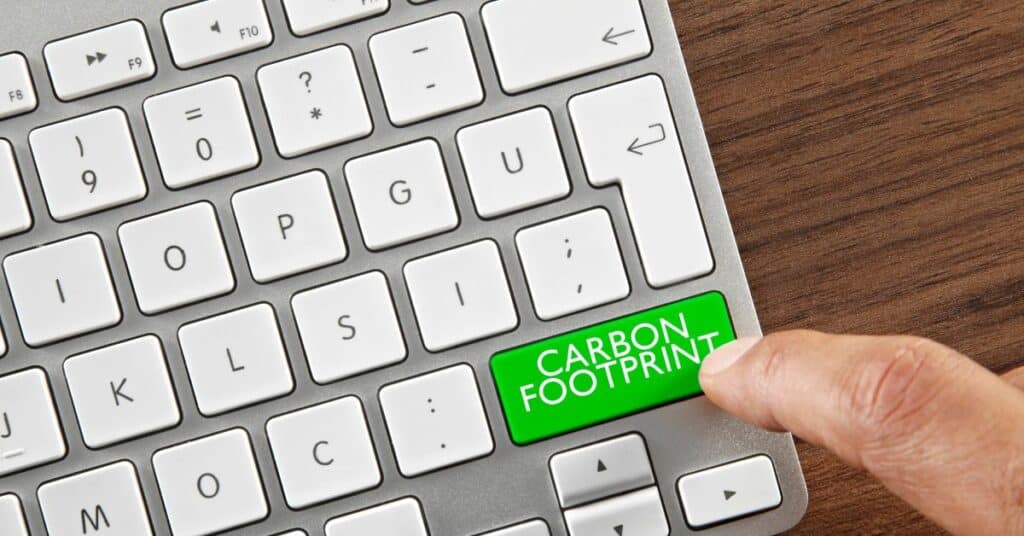More and more companies are publishing their carbon footprints. This is a legal requirement for companies with more than 500 employees, but more and more SMEs are also taking the plunge.
How to do a carbon footprint? What are the benefits? Here are some answers to help you better understand the carbon footprint of your business.

Carbon footprint, carbon balance or Bilan Carbone?
These 3 similar terms are often confused, and it’s important to understand their nuances.
What’s the difference between a carbon footprint and a carbon balance?
The carbon footprint is the quantity of greenhouse gases released into the atmosphere. It can be calculated for a product, a person, a company, an industrial sector or an entire country.
Carbon footprinting is the measurement tool used to determine this carbon footprint. It’s a set of calculation rules that allows us to obtain a standardized result, so that we can compare carbon footprints and measure the impact of measures implemented to improve them.
Bilan Carbone or carbon footprint?
Bilan Carbone is a methodology introduced by ADEME in 2004 and managed since 2011 by the Association Bilan Carbone (ABC). This tool is the most widely used in France, but it is not the only method for establishing a carbon footprint).
There are various international standards for carbon accounting. Among these, the most frequently used are :
- Greenhouse Gas Protocol (GHG Protocol)
- The ISO 14064 standard
With the exception of mandatory GHG assessments, companies are free to choose the methodology used to carry out their carbon footprint.
Why carry out a corporate carbon audit?
In France, all legal entities with more than 500 employees (or 250 for the French overseas departments), as well as public establishments with more than 250 employees and local authorities with more than 50,000 inhabitants, are required to carry out a Bilan Carbone and publish it on the ADEME website. The Bilan Carbone must be updated regularly.
For all other companies not subject to the legal obligation, associations and local authorities, the choice may be dictated by several factors:
Anticipating legal obligations
Although nothing has been decided at the time of writing, it is highly likely that the obligation to publish a Bilan Carbone will be extended to SMEs and startups, as well as to all public establishments.
Taking the CSRD (Corporate Sustainability Reporting Directive) as an example, this will come into force in 2024 for large companies, and will be extended in 2025 to companies with more than 250 employees. It is therefore quite possible that the obligation to produce a carbon footprint will follow the same criteria.
The ambitious gas emission reduction targets for 2050, and the recommendations made by the Citizens’ Climate Convention, suggest that this obligation will come sooner rather than later, and companies will need to be ready.
Enhanced brand image
A company that is aware of its impact on the environment and takes concrete action to improve it is better perceived not only by the public, but also by its partners (suppliers, investors, etc.) and employees.
This can become a strong commercial advantage: an eco-responsible company attracts investors, motivates employees and reassures consumers. It is also increasingly in demand from third-party financiers such as banks, investment funds and BPI.
Economic benefits
More pragmatically, carbon footprinting can lead to significant savings, both in the short and long term. Indeed, reducing GHG emissions is often synonymous with :
- Reduced energy consumption
- Industrial process optimization
- Lower procurement costs

How to do a carbon footprint?
Whatever the methodology used, the principle always remains the same:
- Define a perimeter
- Define a study period
- Assembling data
- Analysis and reporting
- Drawing up an action plan
The scope of carbon assessment studies
In order to establish a carbon footprint, it is important to know which scope to study: direct emissions, indirect emissions, impact of the supply chain… There are 3 categories:
- Scope 1 : This is the most restricted scope, measuring only direct emissions linked to activity, such as energy consumption.
- Scope 2 : Indirect emissions are also taken into account, such as the source of the energy used (electricity generated by on-site photovoltaic panels, or from a coal-fired power plant).
- Scope 3 : This is the most comprehensive assessment, and also includes upstream (supply chain) and downstream (distribution chain) gas emissions.
Time scope
As in accounting, the carbon footprint only takes the past into account, in order to be based on real data. In this sense, it should not be confused with the “carbon budget”, which is a forecast.
In most cases, the carbon footprint covers a 12-month period, i.e. the past year. Depending on the company’s needs, however, it is perfectly possible to set up a monthly carbon footprint, which enables much more precise monitoring.
Which GHGs should be included in a carbon footprint?
Contrary to popular belief, CO2 is not the only greenhouse gas to be taken into account in a Bilan Carbone. Measured data must include other gases:
- Methane (CH4)
- Hydrofluorocarbons (HFCs)
- Nitrous oxide (N2O)
- Perfluorocarbon (PFC)
- Sulfur hexafluoride (SF6)
Depending on the methodology used, other GHGs may also be taken into account.
Who can carry out a carbon assessment for a company?
There are several ways for companies to measure their carbon footprint:
Software and online platforms
These tools, which can be free or for a fee, enable you to carry out an assessment quickly, without mobilizing a large number of resources.
It’s an excellent solution for a first carbon footprint, to “raise awareness” of the problem, but generally doesn’t allow you to go much further. These software programs are rarely adapted to a company’s reality, do not allow for proper monitoring, and above all do not help to reduce emissions.
An external professional
They may be consulting firms or specialized freelancers.
This is the preferred solution for the majority of SMEs and ETIs, who benefit from all the knowledge of an experienced GHG management professional. Not only is the carbon footprint comprehensive, but it can also provide a wealth of advice on how to improve your company’s carbon footprint, keeping you up to date with legal obligations and “best practices in implementing action plans”.
On the other hand, an external firm will need time to learn about the company’s particularities.
In-house training
Having one or more people trained to carry out a carbon footprint, implement monitoring methods and suggest areas for improvement is probably the best solution. It combines experience in GHG management with knowledge of business practices.
However, it’s a solution that requires significant investment and time to implement effectively.
🙋 If you would like a trusted third party to help you carry out a carbon assessment, contact our teams!
🌿 Pour découvrir ou redécouvrir l’ensemble de nos offres Impact / RSE, c’est par ici !











